
Young Banana Tree
Banana is the common name for both the fruit and the herbaceous plants of the genus Musa, which produce this widely consumed fruit. Originating from the tropical regions of Southeast Asia and Australia, bananas are now cultivated throughout tropical areas worldwide.
Belonging to the family Musaceae, banana plants are primarily grown for their fruit, though they are also valued for fiber production and as ornamental plants. Despite often being mistaken for trees due to their tall, upright, and sturdy appearance, banana plants have a main or upright stem known as a pseudostem, meaning "false stem." This pseudostem can reach heights of 2 to 8 meters, with leaves extending up to 3.5 meters in length. Each pseudostem produces a bunch of bananas, which can be yellow, green, or even red, before dying and being replaced by a new pseudostem.

Young Banana Tree
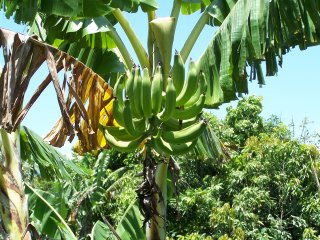
Mature Banana on the Tree
The fruit grows in hanging clusters, with up to 20 fruits per tier (called a hand) and 3 to 20 tiers per bunch. The entire hanging cluster is referred to as a bunch or commercially as a "banana stem," which can weigh between 30 to 50 kilograms. Each banana, or 'finger,' weighs about 125 grams, consisting of approximately 75% water and 25% dry matter. The fruit has a protective outer peel and an edible inner portion, with numerous strings (phloem bundles) running between the peel and the flesh. Bananas are a rich source of vitamin B6, vitamin C, and potassium.
Bananas are cultivated in at least 107 countries. In popular culture and commerce, the term "banana" usually refers to sweet, soft "dessert" bananas that are typically eaten raw. Plantains, a group of cultivars with firmer, starchier fruit, are generally used in cooking rather than eaten raw. Bananas can also be dried and consumed as a snack, or ground into banana flour
.Wild banana species contain numerous large, hard seeds, but almost all culinary bananas are seedless. They are classified as either dessert bananas (yellow and fully ripe when eaten) or green cooking bananas. Nearly all exported bananas are dessert types, but only 10-15% of total banana production is exported, with the U.S. and EU being the primary buyers.
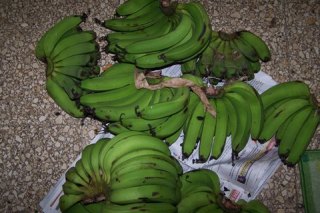
Green Banana
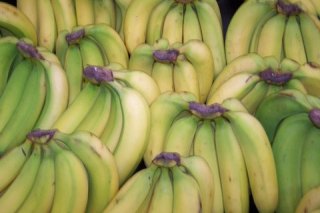
Ripe Banana
Bananas come in various sizes and colors when ripe, including yellow, purple, and red. They can be eaten raw, though some varieties are typically cooked first. The flesh's taste can range from starchy to sweet, and its texture from firm to mushy, depending on the cultivar and ripeness. Unripe or green bananas and plantains are used in cooking various dishes, such as banana pudding, and are staple starches in many tropical regions. Banana sap, which is extremely sticky, can be used as an adhesive and can be obtained from the pseudostem, fruit peelings, or flesh.
The banana plant's flower, known as the banana blossom or banana heart, is used in Southeast Asian, Bengali, and Kerala (India) cuisine, either raw with dips or cooked in soups and curries. The tender core of the banana plant's trunk is also used in dishes such as Burmese mohinga and in Bengali and Kerala cooking. In Malaysia, Singapore, and Indonesia, bananas fried in batter are a popular dessert, often served with ice cream. In Myanmar, bananas are eaten deep-fried, baked in their skin, or steamed in glutinous rice wrapped in banana leaves. Bunches of green bananas surrounding a green coconut are traditionally offered to the Buddha and the Nats. Juice extracted from the tender core is used to treat kidney stones.
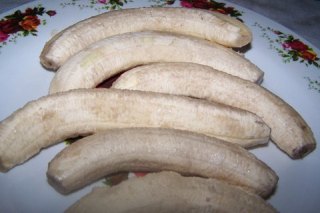
Green Banana for Boiling
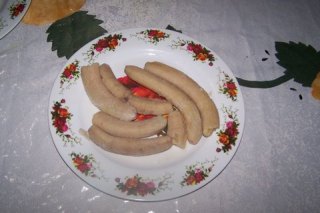
Boiled Banana
The large, flexible, and waterproof banana leaves have various uses, including as umbrellas and food wrappers for cooking, carrying, and packing. In South India, food is traditionally served on banana leaves, a practice also followed by some restaurants. In Chinese and Central American cuisines, banana leaves are used to steam zongzi and tamales, respectively. In Puerto Rico, pasteles are boiled wrapped and tied inside banana leaves. Some farmers grow banana plants specifically for their leaves due to their multiple applications.
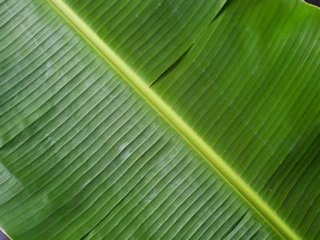
Banana Leaf